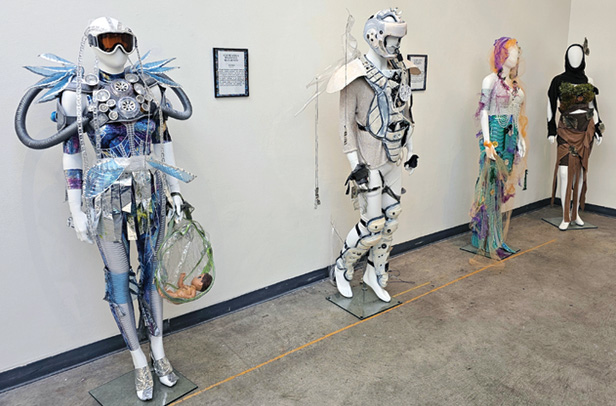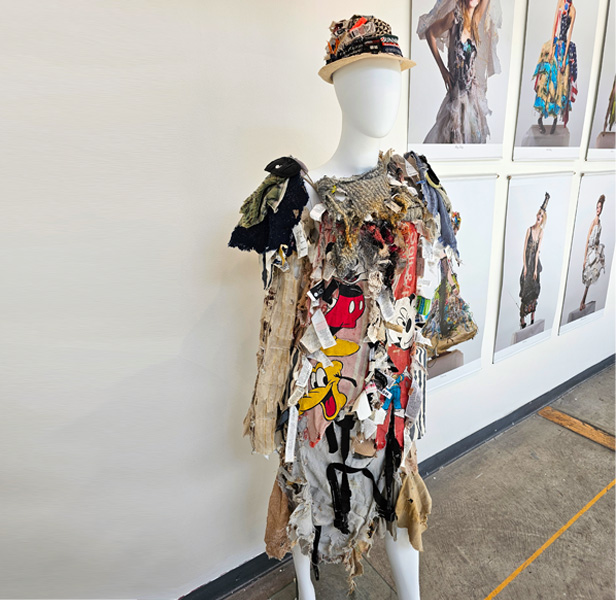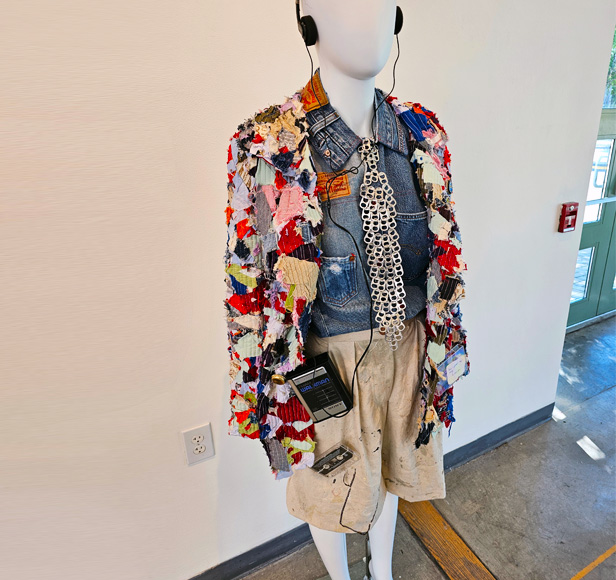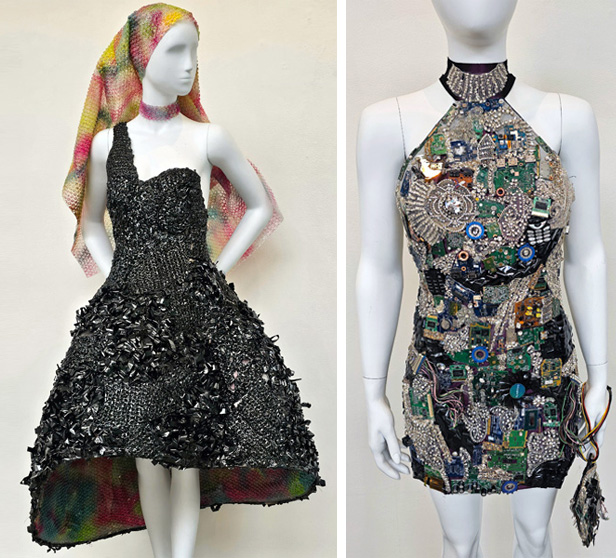Sustainability June 12, 2024
Artists Take on Fast Fashion in Timely Exhibit
ReFash, a Bethlehem, PA, art show that features outfits made from at least 50% upcycled materials, joins a growing conversation about the dangers of overconsumption.
It’s an issue that’s being discussed more and more: how fast fashion – cheaply made and easily discarded – is causing lasting harm to both people and planet.
Back in April, environmental group Desierto Vestido teamed up with Brazilian activists and an advertising agency to put on a fashion show in Chile’s Atacama desert – a destination that’s become a dumping ground for fast fashion. (Chile is the third-largest importer of secondhand clothes in the world; some of it its resold in secondhand markets, but at least 39,000 tons ends up piled in the desert each year, The Guardian notes.)
Atacama fashion week 2024, dubbed “the first fashion week in the largest fashion landfill,” was a collection of eight outfits designed by Brazilian visual artist Maya Ramos and created from apparel waste sourced from the desert. The images of models vamping across piled up heaps of trashed fashion as if they were a catwalk were striking, to say the least.

ReFash, an exhibit on display at The Banana Factory in Bethlehem, PA, is a timely examination of the environmental ravages of fast fashion and overconsumption.
Also during Earth Month, “Brandy Hellville,” a documentary about a popular beachy – but also wasteful and exploitative – fast fashion brand debuted on HBO. The film detailed how approximately 15 million pieces of secondhand clothing from North America, Europe and Australia are dumped weekly in Ghana, where about 40% of it is then discarded.
Even Saturday Night Live is weighing in on the scourge of fast fashion, recently airing a parody commercial for fictional (but easily recognizable) brand “Xiemu,” in which actors posed in trendy togs while a cheerful voiceover assures them, unprompted, that their clothing wasn’t made with forced labor and that it contains “minimal lead.” As the outfits they’re wearing begin to fall apart and the disembodied narrator’s assurances get more disturbing, the ad ends with the question: “Would you stop buying it?” The answer, from guest host Jake Gyllenhaal and other cast members, is a somewhat shamefaced no.
View this post on Instagram
In my role as editor of ASI’s Promo for the Planet initiative, I’ve been watching the global conversation around wasteful fashion grow in volume and intensity over the last few years. So, when I learned that an art gallery in my proverbial backyard was hosting a show to shine a light on fast fashion’s vagaries and promote upcycling, I knew I had to find out more.
The ReFash exhibition, on display until July 7 at The Banana Factory in Bethlehem, PA, features a handful of independent designers who were charged with creating looks made from at least 50% discarded materials. The pieces had to be “wearable, use suitable materials, balance aesthetics and functionality, consider ethical implications” and employ innovative techniques, according to the gallery. The garments and accessories in the show use a diverse mix of materials – everything from old CDs adding shine to a woven dryer sheet purse to an avant-garde gown and headpiece made from VHS tape and spray-painted bubble wrap.
Also incorporated into the exhibit are some stark statistics about fast fashion: The average U.S. consumer throws away 81.5 pounds of clothing each year; the number of times a garment is worn has declined around 36% in 15 years; fast-fashion brands are producing twice the amount of clothes today than in 2000; nearly 10% of microplastics entering the ocean each year came from textiles; 2.6 million tons of returned clothes ended up in U.S. landfills in 2020 alone.
Barbara Kavchok, a bridalwear designer and the curator of the exhibit, says fast fashion actually began with good intentions: “democratizing high-fashion aesthetics for the common consumer at a cost-effective price.” But, of course, you know what they say about good intentions and their usefulness as paving material.
“The prices of these [fast fashion] garments are so suspiciously low, it’s too good to be true,” Kavchok says. “The way they’re made and the amount of them that are made is planned obsolescence – they’re designed to break down. … It’s really bad when you buy kids clothing, and it breaks down before they outgrow them.”
With the exhibit, Kavchok wanted to explore the crisis of overconsumption and how many people treat their clothing as disposable. “I think the way to fix this is to starting thinking of slow fashion and choosing clothing that you know will be a staple piece in your wardrobe,” she shares.
Other solutions outlined in the exhibit include promoting “waste-led design” – a focus on circularity where a product’s end of life is considered at the beginning of the design process – and “clean landfills” that are monitored to ensure toxins don’t leak into the environment and methane gases are collected and burned to create electricity.

This dress by Marina DeBris is made from clothing tags and fabrics that washed up on beaches in Sydney, Australia.
The show featured the work of designers, both local and global, and I was blown away by the variety of materials the artists employed in their looks. Australia-based artist Marina DeBris had two works in the show: One, dubbed “A Captive Audience,” is made from plastic netting found by a sea captain in the Great Pacific Garbage Patch. Another of her garments in the show is made from clothing tags and fabrics that washed up on Sydney beaches. Weathered images of Mickey Mouse and other cartoon characters, along with tags from fast-fashion brands like H&M, are readily apparent in the textured, tattered frock.
“She’s been doing this for a long time as an artform,” Kavchok says of DeBris. “She’s kind of been viewed as more of an activist and artist, but as a fashion designer, I see her work as inspiring.”

This outfit by Brianna Beidler is made from fabric scraps, can tabs, paper clips, chain, jeans, a drop cloth, headphones and a cassette tape.
Another outfit, created by Brianna Beidler, a 19-year-old fashion designer from Reading, PA, featured a collared shirt made from discarded jeans and a necktie crafted from metal soda can pull tabs.

Barbara Kavchok, a bridal designer and exhibit curator, featured several of her own works in the exhibit, including dresses made of VHS tape and discarded computer parts.
Kavchok showed several of her own pieces in the exhibit. The aforementioned VHS-tape gown with bubble-wrap headdress is one of hers, as well as a “techno-chic” minidress made from computer boards and wires and mixed with “lavish crystal beading” to symbolize “the elegance of technology in its most abstract form.”
Kavchok says she’s hoping to attract two different kinds of people to the show and have them each leave with a new perspective. For those interested in fashion, she’s hoping the fast-fashion stats incorporated into the exhibit will open their eyes and empower them to “make meaningful change” in their lives. For environmentalists who might not have an interest in fashion, she’s aiming to show them that “fashion is an art form” and have them draw inspiration from the innovative way the garments turned trash into works of art.
I know I was inspired by both the artistry of the “trash-ion” on display, as well as the exhibit’s sustainability call to action to reduce, reuse and repurpose my wardrobe as much as possible. But, also, I kind of wish I owned a techno-chic minidress – and had an occasion to wear it.

Promo for the Planet is your destination for the latest news, biggest trends and best ideas to help build a more sustainable and socially-responsible industry.
